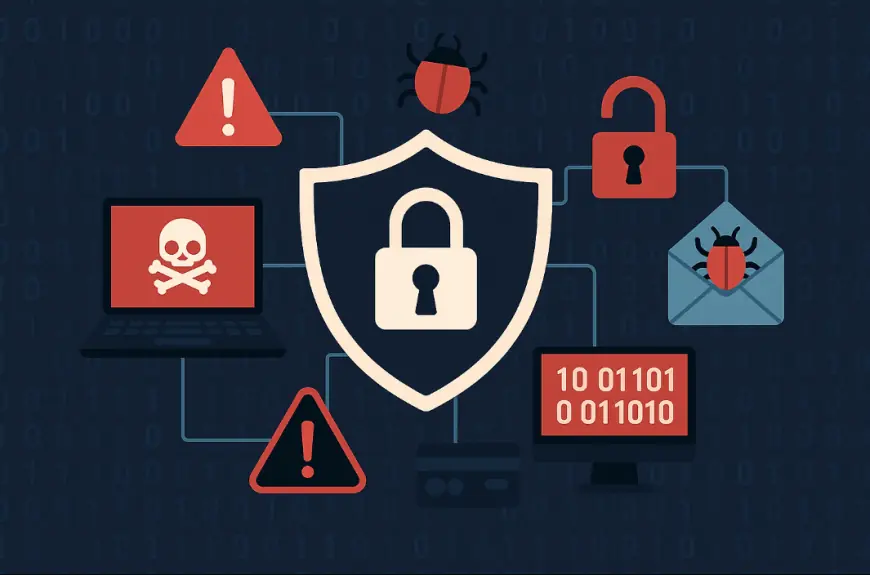Beyond Ransomware: Cybersecurity Threats 2025 You Need to Know
The world of cybersecurity is evolving at a rapid pace. While ransomware has dominated headlines in recent years, experts warn that the digital threats of tomorrow will be far more sophisticated, stealthy, and destructive. As we move into 2025, businesses and individuals alike must prepare for an expanded cybersecurity threats 2025 that extend far beyond the traditional ransomware model.

The world of cybersecurity is evolving at a rapid pace. While ransomware has dominated headlines in recent years, experts warn that the digital threats of tomorrow will be far more sophisticated, stealthy, and destructive. As we move into 2025, businesses and individuals alike must prepare for an expanded cybersecurity threats 2025 that extend far beyond the traditional ransomware model.
From AI-driven cyber attacks to supply chain vulnerabilities, the digital battlefield is growing more complex, and failing to prepare could result in devastating financial, operational, and reputational damage. This guide explores the most critical cybersecurity threats in 2025 and how to defend against them.
The Rising Tide of Cyber Attacks
Cyber attacks are no longer isolated incidents targeting large corporations. Instead, they have become global-scale threats, impacting governments, healthcare systems, financial institutions, and even small businesses. According to industry analysts, cybercrime costs are expected to rise dramatically by 2025, making cyber resilience a top priority for organizations worldwide.
Ransomware may still be dangerous, but the real story of 2025 is the diversification of attack strategies. Cybercriminals are shifting tactics, exploiting new technologies, and leveraging automation and artificial intelligence to outpace traditional security defenses.
Emerging Cybersecurity Threats in 2025
1. AI-Powered Cyber Attacks
Artificial intelligence has become a double-edged sword. While it strengthens defense systems through automation and real-time threat detection, it is also being weaponized by attackers.
-
Automated phishing campaigns can mimic human behavior more convincingly than ever.
-
AI-driven malware can adapt on the fly, making detection nearly impossible.
-
Attackers can use deepfake technology to impersonate executives and trick employees into authorizing fraudulent transactions.
2. Supply Chain Exploits
The interconnected nature of today’s global economy means that a single weak link in the supply chain can compromise entire industries. Attackers now target vendors, contractors, and third-party providers to gain backdoor access to critical infrastructure.
-
Compromised software updates can spread malware across thousands of organizations.
-
Hardware tampering during manufacturing poses long-term security risks.
-
Smaller suppliers often lack robust cybersecurity, making them easy entry points.
3. Critical Infrastructure Attacks
Energy grids, water systems, transportation networks, and healthcare facilities are all potential targets in 2025. Nation-state actors and cybercriminal groups alike understand that crippling critical infrastructure causes maximum disruption.
-
Power outages can be orchestrated remotely.
-
Hospitals can be brought to a standstill by locking patient data.
-
Transportation delays can ripple across global supply chains.
4. Cloud Security Breaches
With the majority of businesses shifting to cloud platforms, attackers are finding new ways to exploit misconfigured systems and poorly secured APIs.
-
Cloud misconfigurations remain one of the biggest threats.
-
Cross-tenant attacks allow hackers to infiltrate multiple organizations at once.
-
Shadow IT—employees using unauthorized cloud services—creates hidden vulnerabilities.
5. IoT and Smart Device Exploits
The Internet of Things (IoT) continues to expand, with billions of connected devices in homes, cities, and industries. Unfortunately, many IoT devices lack strong security measures, making them prime targets.
-
Hackers can compromise smart homes or offices through weak default passwords.
-
Industrial IoT systems (like factory sensors) can be hijacked to disrupt production.
-
Medical IoT devices such as pacemakers and insulin pumps raise life-threatening risks if hacked.
6. Insider Threats and Human Error
Not all cyber attacks come from outside. In 2025, insider threats—whether intentional or accidental—remain one of the most damaging forms of cyber risk.
-
Disgruntled employees may leak sensitive information.
-
Phishing attacks prey on employee mistakes.
-
Lack of cybersecurity awareness increases vulnerability.
7. Quantum Computing Risks
While still emerging, quantum computing poses a looming threat. Once it reaches maturity, quantum computers could break existing encryption methods, rendering current data protection obsolete. Organizations relying on outdated security protocols risk massive exposure.
The Financial & Operational Impact of Cyber Attacks
The cost of cyber attacks in 2025 goes far beyond ransom payments or stolen data. The real damage includes:
-
Downtime costs – Businesses lose millions during system shutdowns.
-
Reputational harm – Customers lose trust when data breaches occur.
-
Regulatory penalties – Failing to comply with evolving cybersecurity laws leads to fines.
-
Supply chain disruption – One cyber attack can impact hundreds of downstream businesses.
In short, the financial and operational impact of cybercrime is expected to surpass traditional business risks, making it one of the top concerns for executives worldwide.
Strategies to Defend Against Cybersecurity Threats 2025
1. Strengthen Cyber Hygiene
-
Implement strong password policies and multi-factor authentication.
-
Regularly patch and update all systems.
-
Reduce reliance on default security settings.
2. Leverage AI for Defense
-
Use AI-powered detection tools to identify anomalies.
-
Automate threat responses to minimize reaction times.
3. Secure the Supply Chain
-
Conduct thorough vendor security assessments.
-
Require third-party compliance with cybersecurity standards.
4. Improve Cloud Security
-
Monitor and audit cloud configurations regularly.
-
Use zero-trust architecture to limit access.
5. Educate Employees
-
Train staff to recognize phishing and social engineering.
-
Conduct regular security drills.
6. Prepare for Quantum Threats
-
Begin exploring quantum-resistant encryption methods.
-
Work with cybersecurity experts to future-proof sensitive data.
Conclusion
As we look beyond ransomware, the cybersecurity threats of 2025 are more complex, interconnected, and potentially devastating. From AI-driven malware to quantum computing risks, organizations must evolve their defenses or risk falling victim to cybercriminals who are always one step ahead.
The key takeaway is simple: cyber attacks are not optional—it’s a necessity. Businesses and individuals must adopt proactive, layered strategies to ensure resilience in the face of evolving threats.
By understanding the challenges ahead and implementing strong defenses today, we can stay ahead of the curve and protect our digital future.
What's Your Reaction?
 Like
0
Like
0
 Dislike
0
Dislike
0
 Love
0
Love
0
 Funny
0
Funny
0
 Angry
0
Angry
0
 Sad
0
Sad
0
 Wow
0
Wow
0




















































